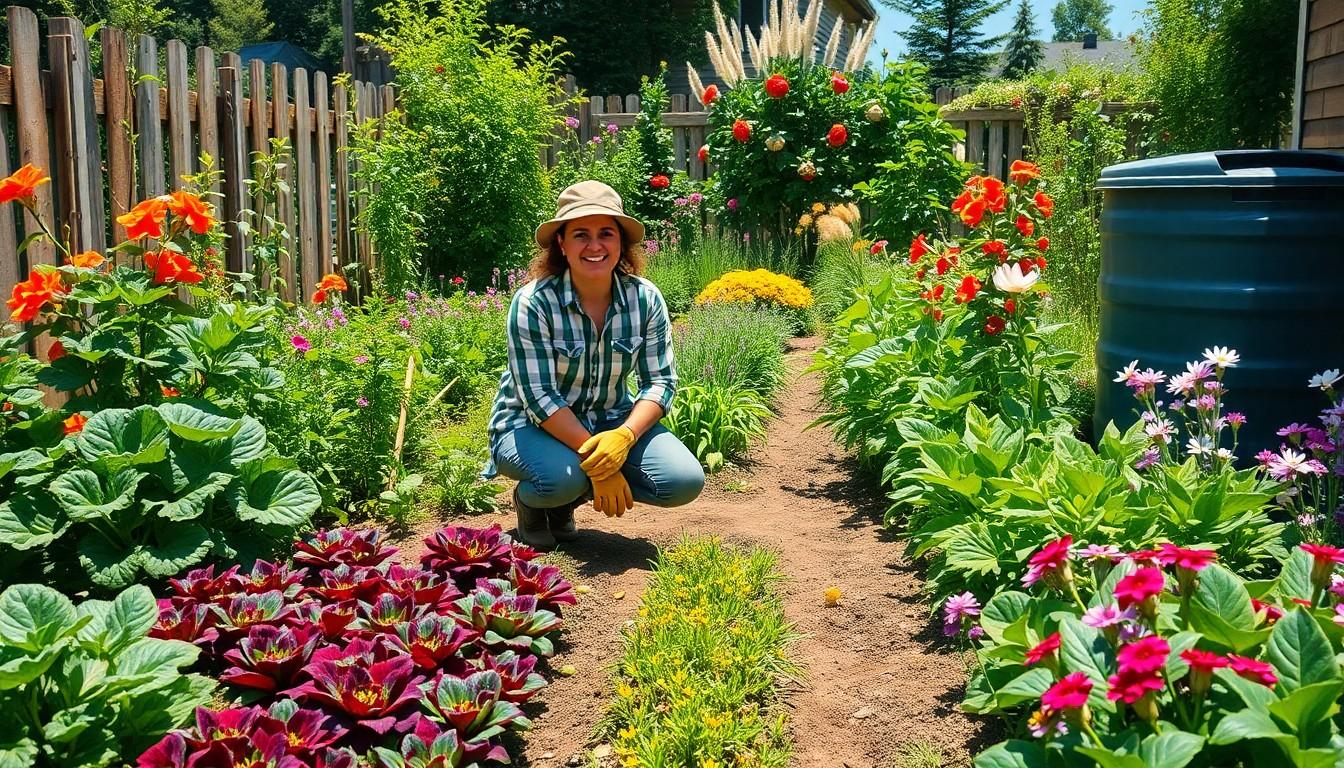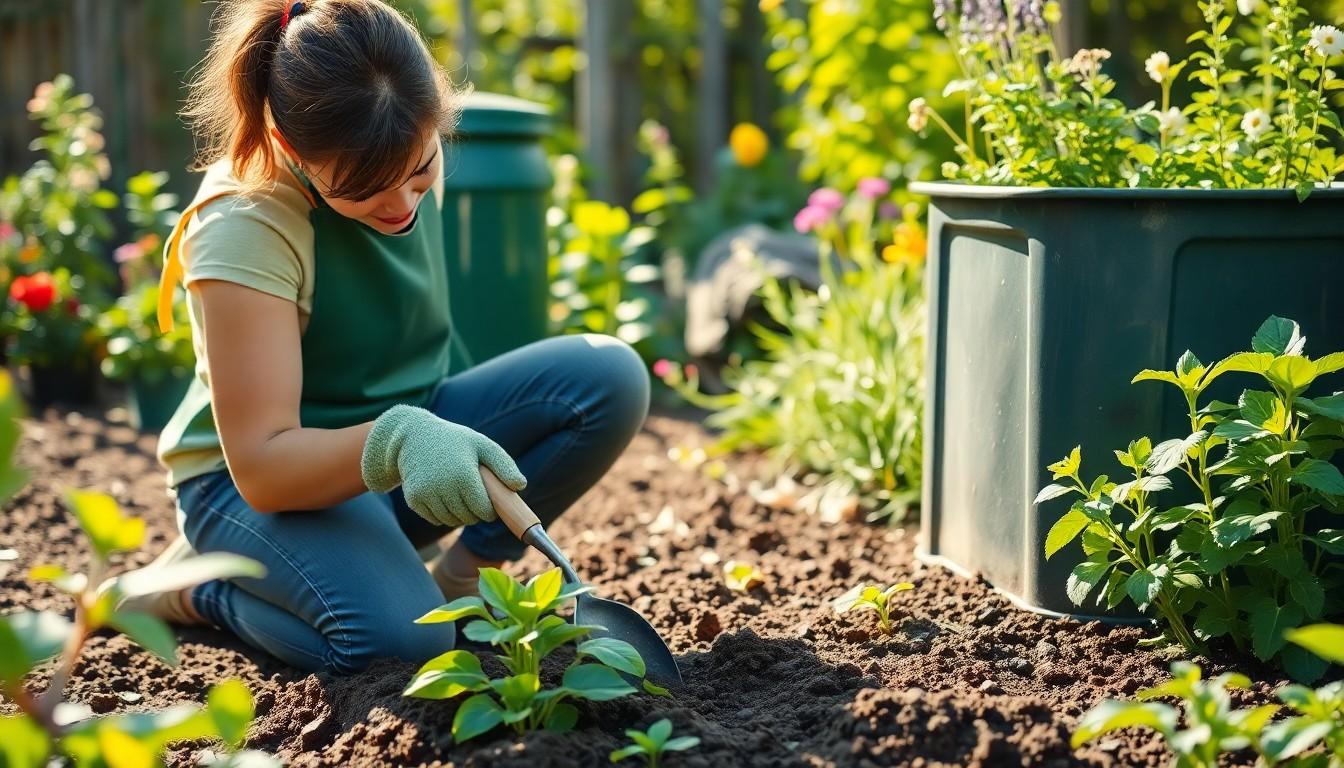Phone:
(701)814-6992
Physical address:
6296 Donnelly Plaza
Ratkeville, Bahamas.

Imagine stepping into your backyard oasis, where vibrant veggies and fragrant herbs thrive without a hint of chemical warfare. Sustainable gardening isn’t just a trend; it’s a way to cultivate your green thumb while giving Mother Nature a high-five. For beginners, it might seem daunting, but fear not! With a little guidance and a sprinkle of humor, anyone can turn their patch of dirt into an eco-friendly paradise.
Sustainable gardening fosters an eco-friendly approach that connects the gardener with nature. This practice emphasizes minimizing environmental impact while enhancing plant health and soil quality.
Sustainable gardening refers to cultivating plants in a way that maintains ecological balance. Techniques often include using organic methods, conserving water, and promoting biodiversity. Incorporating composting reduces waste and enriches soil. Selecting native plants supports local wildlife and encourages a healthy ecosystem. This gardening style prioritizes sustainability, creating a resilient environment for generations.
Sustainable gardening offers numerous advantages for both the gardener and the environment. Healthy soil improves nutrient availability, allowing plants to thrive. Reduced chemical use enhances food safety, promoting healthier diets. Water-saving practices, such as rainwater harvesting, conserve precious resources. Gardening with native species encourages pollinator populations, which are essential for plant reproduction. Overall, this approach creates not just vibrant gardens, but also supports a sustainable future.

Starting with sustainable gardening requires a basic understanding of tools and site selection. Beginners can create thriving eco-friendly gardens with the right preparations.
Using essential tools simplifies the gardening process. A trowel allows for easy digging and transferring soil. Garden gloves protect hands from sharp objects and dirt. Pruners support maintaining plant health by removing dead growth. A watering can facilitates precise watering, while a compost bin aids in recycling kitchen scraps into nutrient-rich compost. These tools enhance the gardening experience, enabling effective management of plants and soil.
Selecting the right location is crucial for successful sustainable gardening. Observing sunlight patterns helps identify areas with adequate light for plant growth. Proximity to water sources simplifies irrigation efforts. Choosing well-drained soil allows for healthier root development. Considering wind exposure can protect fragile plants from damage. Assessing the area for accessibility makes maintenance tasks more manageable. These factors collectively contribute to a thriving sustainable garden environment.
Healthy soil forms the foundation of sustainable gardening. Its quality directly impacts plant health, nutrient availability, and water retention. Organic matter enriches the soil, promoting beneficial microbial activity. Healthy soil reduces the need for chemical fertilizers and encourages a thriving ecosystem.
Healthy soil supports robust plant growth. Nutritious soil means plants can access essential nutrients, which boosts overall vitality. Microorganisms play a key role in breaking down organic materials, releasing nutrients. Soil that retains moisture helps plants survive periods of drought. A well-aerated soil structure promotes root development, contributing to plant resilience.
Creating compost enriches soil and reduces waste. Start with kitchen scraps like vegetable peels and eggshells, along with garden debris such as leaves and grass clippings. Layering materials ensures adequate aeration during decomposition. Regularly turning the compost heap accelerates the breakdown of organic matter. Finished compost adds vital nutrients to the soil, enhancing plant health and growth.
Selecting the right plants lays the foundation for a successful sustainable garden. Beginner gardeners benefit from understanding plant choices that thrive in their environment.
Native plants suit local climates, require less maintenance, and often resist pests and diseases. They provide habitats for wildlife, fostering biodiversity in the garden. Birds and pollinators benefit immensely from this approach, contributing to plant reproduction. Additionally, native plants enhance soil health by preventing erosion and improving water retention. Incorporating them into gardens supports regional ecosystems, creating balance. Examples include coneflowers, black-eyed Susans, and milkweed, which thrive under various conditions.
Adapting to seasonal planting ensures robust growth and harvests. Spring serves as an ideal time for sowing cool-season crops like lettuce and spinach. Summer allows for planting heat-loving vegetables such as tomatoes and peppers. Fall planting includes root vegetables like carrots and potatoes, which flourish in cooler weather. Recognizing frost dates and understanding local climate patterns enhances timing. Planting in succession maximizes yield and maintains continuous harvests throughout the growing season. Careful attention to seasonal shifts establishes a vibrant and productive garden.
Water is a precious resource in sustainable gardening. Implementing effective water conservation techniques ensures healthy plants while minimizing waste.
Understanding watering needs is essential. Drip irrigation delivers water directly to the roots, reducing evaporation and runoff. Watering early in the day limits evaporation losses. Mulching around plants retains moisture while suppressing weeds. A rain gauge helps monitor rainfall, ensuring optimal watering schedules. Adjusting frequency based on weather conditions supports efficient water use.
Rainwater harvesting systems capture runoff from roofs. Installing barrels beneath downspouts collects rainwater for later use. A simple filtration system removes debris, ensuring clean water for plants. Use harvested rainwater for irrigation, reducing reliance on municipal sources. Annual maintenance of the system prevents contamination and enhances efficiency. Positioning barrels near gardens encourages regular usage, maximizing water conservation efforts.
Pest management in sustainable gardening prioritizes environmental health while controlling harmful insects. Various strategies exist that minimize chemical use and promote an ecological balance.
Organic pest control methods focus on natural solutions to prevent and manage pest issues. Neem oil serves as an effective treatment, disrupting the lifecycle of pests. Insecticidal soaps target soft-bodied insects like aphids and spider mites, suffocating them effectively. Introducing diatomaceous earth around plants creates a barrier that deters insects by damaging their protective exoskeletons. Companion planting also offers protection; for instance, marigolds repel nematodes and discourage several pest species. Finally, encouraging a diverse plant community helps prevent infestations, as diversity disrupts pest establishment.
Attracting beneficial insects contributes to a natural pest control ecosystem. Ladybugs serve as effective predators of aphids, providing significant control without chemicals. Planting flowering herbs like dill and cilantro not only adds beauty but also draws in parasitic wasps, which help in controlling caterpillar populations. Including diverse nectar sources encourages pollinator and predator insects. Native plants within the garden naturally attract beneficial insects, promoting balance and fostering a resilient garden system. Additionally, maintaining a habitat for ground beetles aids in controlling soil-dwelling pests, ensuring a healthier environment for plants.
Sustainable gardening offers a rewarding journey that connects individuals with nature while promoting environmental health. By embracing organic practices and focusing on local biodiversity, beginners can cultivate thriving gardens that benefit both themselves and the planet.
With the right tools and knowledge, anyone can transform their outdoor space into a sustainable haven. Each small step taken towards eco-friendly gardening contributes to a larger movement for a healthier future.
As they dig into this fulfilling hobby, gardeners not only enjoy the fruits of their labor but also play a vital role in preserving the environment for generations to come.